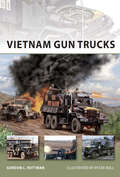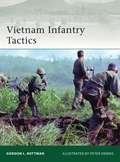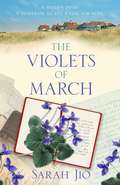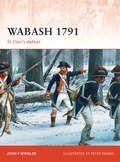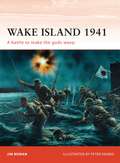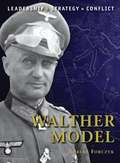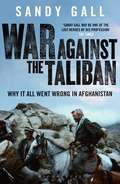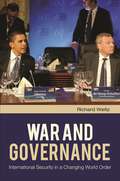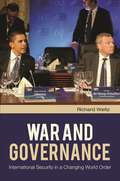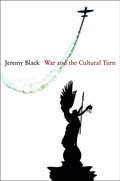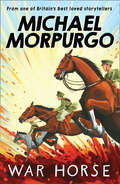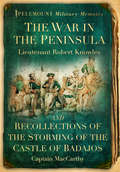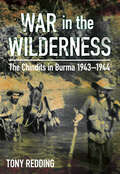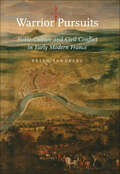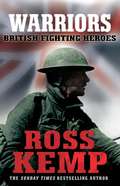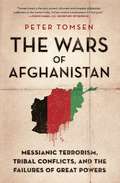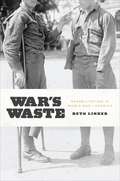- Table View
- List View
Vietnam Gun Trucks (New Vanguard #184)
by Gordon L. RottmanWhile Vietnam is usually perceived as an infantry war, with US forces deploying by helicopter, the long supply lines that led to their inland bases had to be traveled by ground vehicles. The 8th and 48th Transportation Groups were responsible for hauling supplies through the long, dangerous roads of Vietnam, and they often found themselves the target of ambushes, attacks, and sniping. In response to this, vehicle crews began to arm trucks with machine guns and armour them with sandbags. While these proved less than ideal, the concept was considered valid, and more and more “gun trucks” appeared, sporting heavier weapons and armor. Written by a Vietnam veteran, this book traces the development of these gun trucks from the jury-rigged originals to the powerful armoured vehicles that appeared later in the war.
Vietnam Infantry Tactics (Elite)
by Peter Dennis Gordon L. RottmanThis book reveals the evolving US, Viet Cong and NVA tactics at battalion level and below throughout the Vietnam War. Beginning with a description of the terrain, climate and the unique nature of operations in this theatre of war, the author, a Vietnam veteran himself, goes on to explain how unit organisation was broken down by combatant forces and the impact this had on the kind of tactics they employed. In particular, the author highlights how units were organised in reality on the battlefield as opposed to their theoretical tables of organisation. US tactics included the standard US tactical doctrine as prescribed by several field manuals and in which leaders and troops were rigourously trained. But it also reveals how many American units developed innovative small unit tactics specifically tailored to the terrain and enemy practices. In contrast, this book also reveals the tactics employed by Viet Cong and NVA units including their own Offensive Operations, Reconnaissance, Movement Formations and Security, and Ambushes.
The Violets of March: A Novel
by Sarah JioThe island has a way of calling you home... Ten years ago, Emily Watson was on top of the world: a best-selling novel, a husband plucked from the pages of a magazine, and a one-way ticket to happily ever after.Now her perfect life has crumbled and Emily is left to pick up the pieces.So when her great-Aunt Bee invites her to spend the month of March on her beloved Bainbridge Island, Emily accepts, longing to be healed by the sea. As she begins researching her next book, Emily discovers a red velvet diary, dated 1943, whose contents reveal a startling secret that could change her life forever... A heart-breaking story of love, hope and second chances, from the international bestselling author of All the Flowers in Paris
Vulcan - Long-range Medium Bomber (large print)
by RnibThis is an image of a jet bomber seen from above. There is a locator dot shown, which will be at the top left of the page when the image is the correct way up. The image is in the centre and a scale in metres on the left of the page. The aircraft nose is in the top centre and the tail in the bottom centre of the page. The fuselage goes up and down the middle of the page. The cockpit is shown as a tiny window near the nose. The wings sweep down to the left and right and are widest at the tail end. Sticking out from the end of the aircraft there are two jet engine nozzles to the left and right of the tail. The bottom edge of the wing has four flaps on each side, these are the ailerons used to manoeuvre the aircraft when it is flying.
Vulcan - Long-range Medium Bomber (UEB contracted)
by RnibThis is an image of a jet bomber seen from above. There is a locator dot shown, which will be at the top left of the page when the image is the correct way up. The image is in the centre and a scale in metres on the left of the page. The aircraft nose is in the top centre and the tail in the bottom centre of the page. The fuselage goes up and down the middle of the page. The cockpit is shown as a tiny window near the nose. The wings sweep down to the left and right and are widest at the tail end. Sticking out from the end of the aircraft there are two jet engine nozzles to the left and right of the tail. The bottom edge of the wing has four flaps on each side, these are the ailerons used to manoeuvre the aircraft when it is flying.
Vulcan - Long-range Medium Bomber (UEB uncontracted)
by RnibThis is an image of a jet bomber seen from above. There is a locator dot shown, which will be at the top left of the page when the image is the correct way up. The image is in the centre and a scale in metres on the left of the page. The aircraft nose is in the top centre and the tail in the bottom centre of the page. The fuselage goes up and down the middle of the page. The cockpit is shown as a tiny window near the nose. The wings sweep down to the left and right and are widest at the tail end. Sticking out from the end of the aircraft there are two jet engine nozzles to the left and right of the tail. The bottom edge of the wing has four flaps on each side, these are the ailerons used to manoeuvre the aircraft when it is flying.
Wabash 1791: St Clair’s defeat (Campaign #240)
by John F. WinklerThe battle of Wabash, or St. Clair's Massacre, was the greatest defeat of the American Army by Native American forces. The campaign opened in 1791, when an newly formed American Army, under the command of Revolutionary War hero, Arthur St. Clair, set off into the wilderness of Ohio in an effort to wrest control of the Northwest Territory from the various native tribes. Plagued by logistical problems, bad weather, and native ambushes, the expedition dragged on for months as the American army slowly eroded due to injury, sickness, and desertion. Then, on a cold November day, an allied Native army descended on the Americans. In the ensuing chaos, the Americans were slaughtered, taking over 90% casualties. In this book, author John F. Winkler, re-examines this one-sided victory, analyzing what the American's did wrong and how the Natives achieved a victory that they could never repeat.
Wake Island 1941: A battle to make the gods weep (Campaign #144)
by Peter Dennis Jim MoranOn the same day that the Japanese attacked Pearl Harbor, they also launched air attacks on Wake Island, an American marine and naval base in the Pacific. Three days later a Japanese invasion force stormed the island, but were bloodily repulsed by the scratch force of marines, sailors and even service personnel who defended it. Despite US attempts to relieve the island, the Japanese launched a much greater invasion a few weeks later and, despite gallant resistance, eventually caused the US Forces to surrender. This book tells the complete story of the vicious fighting on Wake Island, one of the near-legendary 'last stands' made by US military forces.
Walther Model: Leadership, Strategy, Conflict (Command #15)
by Robert Forczyk Adam HookThis volume details the military career and accomplishments of Walther Model, the youngest Generalfeldmarschall in the Wehrmacht in World War II and Hitler's favourite commander. Model was a tough and tenacious commander, particularly when on the defensive, and his career rise was virtually unprecedented in German military history. Model really made his mark late in the war, when time was already running out for the Third Reich, but time and again he was rushed from one crumbling front to the next and succeeded in temporarily restoring the situation. Above all, Model deserves recognition as one of the great defensive commanders of modern military history.
War Against the Taliban: Why It All Went Wrong in Afghanistan
by Sandy GallAfghanistan's strategically significant lands have long been fought over by foreign invaders. Today, as yet another generation risks life and limb in this inhospitable territory, an ever-rising death toll puts back under the spotlight the way the modern war in Afghanistan is being run, and demands answers. Drawing on interviews with Afghan politicians, businessmen and ordinary people, British, American and European diplomats and soldiers, Sandy Gall addresses the challenges - political, religious, and military - that face those now fighting on the most dangerous frontier in the world.
War and Governance: International Security in a Changing World Order (The Changing Face of War)
by Richard WeitzAn insightful and expert assessment examines how best to end—and avert—wars.How do we avoid war? To arrive at an answer, master analyst Richard Weitz explores the ways nations, international organizations, and individuals have sought to bring order to an inherently disorderly phenomenon—potential and actual violent conflict among organized political entities. Specifically, War and Governance: International Security in a Changing World Order analyzes a number of critical issues such as whether regional security institutions have distinct advantages and liabilities in promoting international security, as compared with universal organizations like the United Nations. Other important questions are addressed, as well. How will international organizations, such as the UN, EU, and NATO, change the nature of war in the 21st century—and be changed by it? What role might less formal institutions and nongovernmental organizations play in peacemaking? Will the nation-state remain the most important international security actor? The book ends with a gap analysis that identifies incongruities between international needs and capabilities—and suggests ways to overcome them.
War and Governance: International Security in a Changing World Order (The Changing Face of War)
by Richard WeitzAn insightful and expert assessment examines how best to end—and avert—wars.How do we avoid war? To arrive at an answer, master analyst Richard Weitz explores the ways nations, international organizations, and individuals have sought to bring order to an inherently disorderly phenomenon—potential and actual violent conflict among organized political entities. Specifically, War and Governance: International Security in a Changing World Order analyzes a number of critical issues such as whether regional security institutions have distinct advantages and liabilities in promoting international security, as compared with universal organizations like the United Nations. Other important questions are addressed, as well. How will international organizations, such as the UN, EU, and NATO, change the nature of war in the 21st century—and be changed by it? What role might less formal institutions and nongovernmental organizations play in peacemaking? Will the nation-state remain the most important international security actor? The book ends with a gap analysis that identifies incongruities between international needs and capabilities—and suggests ways to overcome them.
War and the Cultural Turn
by Jeremy BlackIn this stimulating new text, renowned military historian Jeremy Black unpacks the concept of culture as a descriptive and analytical approach to the history of warfare. Black takes the reader through the limits and prospects of culture as a tool for analyzing war, while also demonstrating the necessity of maintaining the context of alternative analytical matrices, such as technology. Black sets out his unique approach to culture and warfare without making his paradigm into a straightjacket. He goes on to demonstrate the flexibility of his argument through a series of case studies which include the contexts of rationale (Gloire), strategy (early modern Britaisn), organizations (the modern West), and ideologies (the Cold War). These case studies drive home the point at the core of the book: culture is not a bumper sticker; it is a survival mechanism. Culture is not immutable; it is adaptable. Wide-ranging, international and always provocative, War and the Cultural Turn will be required reading for all students of military history and security studies.
War and the Cultural Turn
by Jeremy BlackIn this stimulating new text, renowned military historian Jeremy Black unpacks the concept of culture as a descriptive and analytical approach to the history of warfare. Black takes the reader through the limits and prospects of culture as a tool for analyzing war, while also demonstrating the necessity of maintaining the context of alternative analytical matrices, such as technology. Black sets out his unique approach to culture and warfare without making his paradigm into a straightjacket. He goes on to demonstrate the flexibility of his argument through a series of case studies which include the contexts of rationale (Gloire), strategy (early modern Britaisn), organizations (the modern West), and ideologies (the Cold War). These case studies drive home the point at the core of the book: culture is not a bumper sticker; it is a survival mechanism. Culture is not immutable; it is adaptable. Wide-ranging, international and always provocative, War and the Cultural Turn will be required reading for all students of military history and security studies.
War Horse (Oxford Playscripts Ser.)
by Michael MorpurgoBefore the Steven Spielberg film, before the National Theatre production, there was the classic children’s novel…
The War in the Peninsula and Recollections of the Storming of the Castle of Badajos
by Lieutenant Robert Knowles Captain James MacCarthyLieutenant Knowles served in the 7th (Royal) Fusiliers 1811-1813, seeing action in several battles, being wounded at the storming of Badajoz and at the battle of Salamanca. He was killed at Roncesvalles on 25 July 1813 during the Battle of the Pyrenees. By combining the overall picture as painted by Lt Knowles with the specific, bloody narrative of the storming of the Castle by Captain MacCarthy in one volume, this work is not only fantastic value for money but also offers the discerning reader a whole new perspective on the campaign. What did these two men – of different temperaments – make of events? Wellington had watched helplessly at Badajos as the flower of his army was smashed against the ramparts of Badajos: the 4th and Light Divisions attacked no less than 40 times. When they finally succeeded, an orgy of rape, pillage and destruction followed that even the Iron Duke could not quell. What did both men have to say about this? Both of these rare classics are essential reading for students of the period
War in the Wilderness: The Chindits in Burma 1943-1944
by Tony ReddingWar in the Wilderness is the most comprehensive account ever published of the human aspects of the Chindit war in Burma. The word ‘Chindit’ will always have a special resonance in military circles. Every Chindit endured what is widely regarded as the toughest sustained Allied combat experience of the Second World War. The Chindit expeditions behind Japanese lines in occupied Burma 1943–1944 transformed the morale of British forces after the crushing defeats of 1942. The Chindits provided the springboard for the Allies’ later offensives. The two expeditions extended the boundaries of human endurance. The Chindits suffered slow starvation and exposure to dysentery, malaria, typhus and a catalogue of other diseases. They endured the intense mental strain of living and fighting under the jungle canopy, with the ever-present threat of ambush or simply ‘bumping’ the enemy. Every Chindit carried his kit and weapons (equivalent to two heavy suitcases) in the tropical heat and humidity. A disabling wound or sickness frequently meant a lonely death. Those who could no longer march were often left behind with virtually no hope of survival. Some severely wounded were shot or given a lethal dose of morphia to ensure they would not be captured alive by the Japanese. Fifty veterans of the Chindit expeditions kindly gave interviews for this book. Many remarked on the self-reliance that sprang from living and fighting as a Chindit. Whatever happened to them after their experiences in Burma, they knew that nothing else would ever be as bad. There are first-hand accounts of the bitter and costly battles and the final, wasteful weeks, when men were forced to continue fighting long after their health and strength had collapsed. War in the Wilderness continues the story as the survivors returned to civilian life. They remained Chindits for the rest of their days, members of a brotherhood forged in extreme adversity.
Warrior Pursuits: Noble Culture and Civil Conflict in Early Modern France (The Johns Hopkins University Studies in Historical and Political Science #128)
by Brian SandbergWarrior nobles frequently armed themselves for civil war in southern France during the troubled early seventeenth century. These bellicose nobles’ practices of violence shaped provincial society and the royal state in early modern France. The southern French provinces of Guyenne and Languedoc suffered almost continual religious strife and civil conflict between 1598 and 1635, providing an excellent case for investigating the dynamics of early modern civil violence. Warrior Pursuits constructs a cultural history of civil conflict, analyzing in detail how provincial nobles engaged in revolt and civil warfare during this period. Brian Sandberg’s extensive archival research on noble families in these provinces reveals that violence continued to be a way of life for many French nobles, challenging previous scholarship that depicts a progressive "civilizing" of noble culture. Sandberg argues that southern French nobles engaged in warrior pursuits—social and cultural practices of violence designed to raise personal military forces and to wage civil warfare in order to advance various political and religious goals. Close relationships between the profession of arms, the bonds of nobility, and the culture of revolt allowed nobles to regard their violent performances as "heroic gestures" and "beautiful warrior acts." Warrior nobles represented the key organizers of civil warfare in the early seventeenth century, orchestrating all aspects of the conduct of civil warfare—from recruitment to combat—according to their own understandings of their warrior pursuits.Building on the work of Arlette Jouanna and other historians of the nobility, Sandberg provides new perspectives on noble culture, state development, and civil warfare in early modern France. French historians and scholars of the Reformation and the European Wars of Religion will find Warrior Pursuits engaging and insightful.
Warriors: British Fighting Heroes
by Ross KempRoss Kemp has encountered conflict and warfare the world over, broadcasting from some of the most volatile military hot-zones. From meeting the world's deadliest gangsters, to perhaps his hardest assignment of all; embedded with the British Army in Afghanistan's Helmand province, where he witnessed some of the fiercest fighting of the conflict and was trained in the tactics they use to stay alive.Stationed with British forces for his award-winning television documentaries, Ross Kemp has not only experienced the terror and exhilaration of life on the frontline, but also the courage and leadership of today's servicemen and women. The plight of our Armed Forces is one especially close to his heart, and here for the first time Kemp tells the breathtaking stories of commandos, medics, submariners, fighter pilots, infantrymen, sailors and engineers in daring raids, stirring last stands and acts of extreme valour. British Fighting Heroes is Ross Kemp's personal tribute to some of the most remarkable men and women to have served in the British Armed Forces during the two World Wars, many of them unsung or forgotten. From Sgt Major Stan Hollis, D-Day's only VC winner, to Freddie Spencer Chapman the reluctant war hero who spent three years behind enemy lines in Burma fighting guerrilla warfare against troops, each account is an extraordinary tale of courage, adventure and patriotic sacrifice.
The Wars of Afghanistan: Messianic Terrorism, Tribal Conflicts, and the Failures of Great Powers
by Peter TomsenAs Ambassador and Special Envoy on Afghanistan from 1989 to 1992, Peter Tomsen has had close relationships with Afghan leaders and has dealt with senior Taliban, warlords, and religious leaders involved in the region's conflicts over the last two decades. Now Tomsen draws on a rich trove of never-before-published material to shed new light on the American involvement in the long and continuing Afghan war. This book offers a deeply informed perspective on how Afghanistan's history as a "shatter zone” for foreign invaders and its tribal society have shaped the modern Afghan narrative. It brings to life the appallingly misinformed secret operations by foreign intelligence agencies, including the Soviet NKVD and KGB, the Pakistani ISI, and the CIA. American policy makers, Tomsen argues, still do not understand Afghanistan; nor do they appreciate how the CIA's covert operations and the Pentagon's military strategy have strengthened extremism in the country. At this critical time, he shows how the U.S. and the coalition it leads can assist the region back to peace and stability.
War's Waste: Rehabilitation in World War I America
by Beth LinkerWith US soldiers stationed around the world and engaged in multiple conflicts, Americans will be forced for the foreseeable future to come to terms with those permanently disabled in battle. At the moment, we accept rehabilitation as the proper social and cultural response to the wounded, swiftly returning injured combatants to their civilian lives. But this was not always the case, as Beth Linker reveals in her provocative new book, War’s Waste. Linker explains how, before entering World War I, the United States sought a way to avoid the enormous cost of providing injured soldiers with pensions, which it had done since the Revolutionary War. Emboldened by their faith in the new social and medical sciences, reformers pushed rehabilitation as a means to “rebuild” disabled soldiers, relieving the nation of a monetary burden and easing the decision to enter the Great War. Linker’s narrative moves from the professional development of orthopedic surgeons and physical therapists to the curative workshops, or hospital spaces where disabled soldiers learned how to repair automobiles as well as their own artificial limbs. The story culminates in the postwar establishment of the Veterans Administration, one of the greatest legacies to come out of the First World War.
War's Waste: Rehabilitation in World War I America
by Beth LinkerWith US soldiers stationed around the world and engaged in multiple conflicts, Americans will be forced for the foreseeable future to come to terms with those permanently disabled in battle. At the moment, we accept rehabilitation as the proper social and cultural response to the wounded, swiftly returning injured combatants to their civilian lives. But this was not always the case, as Beth Linker reveals in her provocative new book, War’s Waste. Linker explains how, before entering World War I, the United States sought a way to avoid the enormous cost of providing injured soldiers with pensions, which it had done since the Revolutionary War. Emboldened by their faith in the new social and medical sciences, reformers pushed rehabilitation as a means to “rebuild” disabled soldiers, relieving the nation of a monetary burden and easing the decision to enter the Great War. Linker’s narrative moves from the professional development of orthopedic surgeons and physical therapists to the curative workshops, or hospital spaces where disabled soldiers learned how to repair automobiles as well as their own artificial limbs. The story culminates in the postwar establishment of the Veterans Administration, one of the greatest legacies to come out of the First World War.
War's Waste: Rehabilitation in World War I America
by Beth LinkerWith US soldiers stationed around the world and engaged in multiple conflicts, Americans will be forced for the foreseeable future to come to terms with those permanently disabled in battle. At the moment, we accept rehabilitation as the proper social and cultural response to the wounded, swiftly returning injured combatants to their civilian lives. But this was not always the case, as Beth Linker reveals in her provocative new book, War’s Waste. Linker explains how, before entering World War I, the United States sought a way to avoid the enormous cost of providing injured soldiers with pensions, which it had done since the Revolutionary War. Emboldened by their faith in the new social and medical sciences, reformers pushed rehabilitation as a means to “rebuild” disabled soldiers, relieving the nation of a monetary burden and easing the decision to enter the Great War. Linker’s narrative moves from the professional development of orthopedic surgeons and physical therapists to the curative workshops, or hospital spaces where disabled soldiers learned how to repair automobiles as well as their own artificial limbs. The story culminates in the postwar establishment of the Veterans Administration, one of the greatest legacies to come out of the First World War.
War's Waste: Rehabilitation in World War I America
by Beth LinkerWith US soldiers stationed around the world and engaged in multiple conflicts, Americans will be forced for the foreseeable future to come to terms with those permanently disabled in battle. At the moment, we accept rehabilitation as the proper social and cultural response to the wounded, swiftly returning injured combatants to their civilian lives. But this was not always the case, as Beth Linker reveals in her provocative new book, War’s Waste. Linker explains how, before entering World War I, the United States sought a way to avoid the enormous cost of providing injured soldiers with pensions, which it had done since the Revolutionary War. Emboldened by their faith in the new social and medical sciences, reformers pushed rehabilitation as a means to “rebuild” disabled soldiers, relieving the nation of a monetary burden and easing the decision to enter the Great War. Linker’s narrative moves from the professional development of orthopedic surgeons and physical therapists to the curative workshops, or hospital spaces where disabled soldiers learned how to repair automobiles as well as their own artificial limbs. The story culminates in the postwar establishment of the Veterans Administration, one of the greatest legacies to come out of the First World War.
War's Waste: Rehabilitation in World War I America
by Beth LinkerWith US soldiers stationed around the world and engaged in multiple conflicts, Americans will be forced for the foreseeable future to come to terms with those permanently disabled in battle. At the moment, we accept rehabilitation as the proper social and cultural response to the wounded, swiftly returning injured combatants to their civilian lives. But this was not always the case, as Beth Linker reveals in her provocative new book, War’s Waste. Linker explains how, before entering World War I, the United States sought a way to avoid the enormous cost of providing injured soldiers with pensions, which it had done since the Revolutionary War. Emboldened by their faith in the new social and medical sciences, reformers pushed rehabilitation as a means to “rebuild” disabled soldiers, relieving the nation of a monetary burden and easing the decision to enter the Great War. Linker’s narrative moves from the professional development of orthopedic surgeons and physical therapists to the curative workshops, or hospital spaces where disabled soldiers learned how to repair automobiles as well as their own artificial limbs. The story culminates in the postwar establishment of the Veterans Administration, one of the greatest legacies to come out of the First World War.
